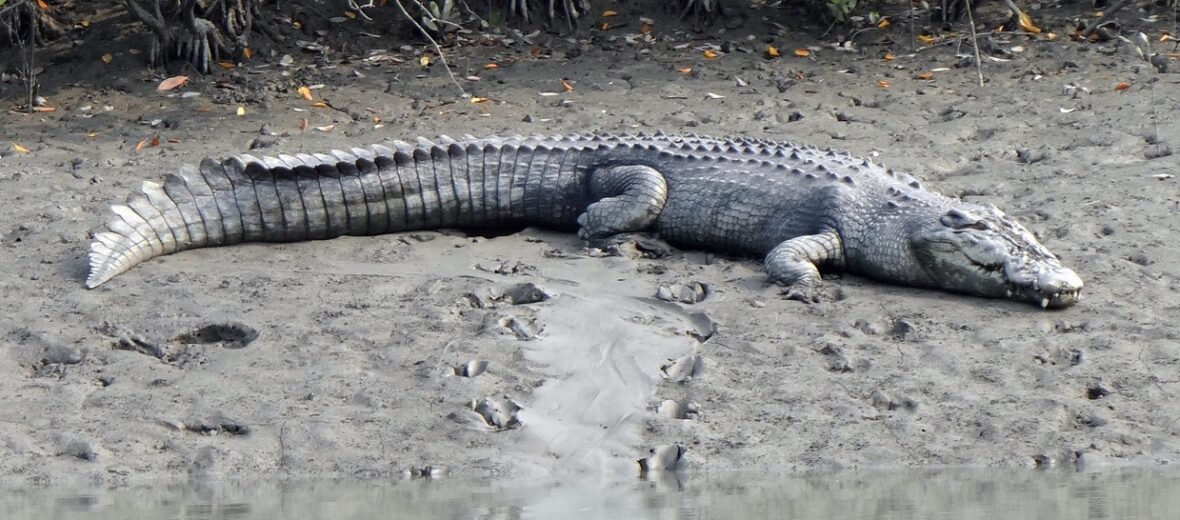
The saltwater crocodile is a crocodilian that is native to saltwater habitats and brackish wetlands from India’s east coast across Southeast Asia and down to the Sundaic region to northern Australia and Micronesia. These stealthy and opportunistic hunters await patiently in the murky water for a passer-by to stop for a drink or to get into the water, then they launch from the water and latch onto their unfortunate victim, drag them into the water, and proceed to engage in what is known as a death roll. After drowning its victim, the crocodile rapidly rolls it in the water in order to remove its limbs and tear off flesh). The IUCN lists these beasts as Least Concern.
First the Stats…
Scientific name: Crocodylus porosus
Weight: Up to 2,200 lbs.
Length: Up to 23 feet
Lifespan: Up to 70 years
Now on to the Facts!
1.) Saltwater crocodiles have many very large teeth and the most powerful bite force of any living animal. Although this bite strength only applies to the closing of their jaws. The opening of their jaws can be stopped with a human’s grip and/or tape.
2.) These beasts are so adapted to life in and near the sea that they’re able to spend days or even weeks at sea, drifting and swimming hundreds of miles at a time. Hence their wide distribution.
3.) Salty crocs can be outrun by a human, as they can only reach land speeds of up to 8.6 mph. But chances are you wouldn’t be in a sprinting contest with a croc., since they will typically attack via the element of surprise.
4.) Their various types of land locomotion are the high walk (walking with their bodies off the ground), belly crawl, dragging their bodies on the ground (used while moving through muddy terrain), and the gallop (used to escape predators while out of water – kind of like a hopping movement).
5.) Like many other reptiles, incubation temperatures dictate male or female. Higher temps yield mostly males and lower temps result in mostly females.
But wait, there’s more on the saltwater crocodile!
6.) Due to widespread predation, only 1% of newborn saltwater crocs survive to adulthood!
7.) The primary prey items include fish, mammals, and birds. They have no problem taking a human either. There are a recorded 30+/- salty attacks on humans each year yielding in a 50% kill ratio! Most attacks are defensive in nature. They are either defending themselves or their nests.
Did you know…?
Australian saltwater crocs are capable of unihemispheric sleep. This involves shutting down only 1 half of their brain at a time, keeping the other half alert to danger!
8.) There are 14 known species of crocodiles alive today; the saltwater crocodile is the largest of them. They can get nearly as large as the width of a soccer goal!
9.) They can swim at speeds of up to 15 mph. You may be able to outrun them, but good luck swimming faster then them. They swim at 3x the speed of the fastest swimmer.
10.) Female salties build large nests made of rotting vegetation, typically next to a body of water. They lay up to 90 eggs and bury them in the leaf litter. They then ferociously guard them till they hatch.
But wait, there’s still more on the saltwater crocodile!
11.) In the 70s, the number of saltwater crocodiles in Australia’s Northern Territory dropped to around 3,000 due to the exotic animal skin trade. With protection and time, their numbers have increased to more than 150,000 recorded adults.
Did you know…?
Saltwater croc hides are valued above all other crocodilians. With illegal hunting, habitat loss, and a general disdain toward them due to its reputation as a man-killer continue to put a steady pressure on their population.
12.) Thanks to a salt-excreting gland located under the tongue, called a lingual gland, the saltwater crocodile is able to survive in the ocean and even hypersaline water without dehydrating.
13.) The saltwater crocodile has a valve located at the back of its throat that allows it to open its mouth in the water while breathing through its nostrils without ingesting any water.
14.) Salties communicate via emitting growling & chirping sounds. These help adults to convey not only reproductive but territorial signs. Hatchlings make chirping noises when about to hatch, to tell their mother to excavate her nest. They will also chirp as a distress call whenever they’re in danger.
15.) Despite being hunted, the IUCN currently lists them as Least Concern.
Now a Short Saltwater Crocodile Video!
Also, check out the Critter Science YouTube channel. Videos added frequently!
Want to suggest a critter for me to write about? Let me know here.



